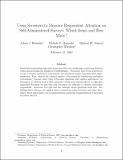Using screeners to measure respondent attention on self-administered surveys: Which items and how many?
Author(s)
Berinsky, Adam; Margolis, Michele F.; Sances, Michael W.; Warshaw, Christopher
DownloadSubmitted version (418.2Kb)
Open Access Policy
Open Access Policy
Creative Commons Attribution-Noncommercial-Share Alike
Terms of use
Metadata
Show full item recordAbstract
Inattentive respondents introduce noise into data sets, weakening correlations between items and increasing the likelihood of null findings. “Screeners” have been proposed as a way to identify inattentive respondents, but questions remain regarding their implementation. First, what is the optimal number of Screeners for identifying inattentive respondents? Second, what types of Screener questions best capture inattention? In this paper, we address both of these questions. Using item-response theory to aggregate individual Screeners we find that four Screeners are sufficient to identify inattentive respondents. Moreover, two grid and two multiple choice questions work well. Our findings have relevance for applied survey research in political science and other disciplines. Most importantly, our recommendations enable the standardization of Screeners on future surveys.
Date issued
2019-11Department
Massachusetts Institute of Technology. Department of Political ScienceJournal
Political Science Research and Methods
Publisher
Cambridge University Press (CUP)
Citation
Berinsky, Adam et al. "Using screeners to measure respondent attention on self-administered surveys: Which items and how many?" Political Science Research and Methods (November 2019): dx.doi.org/10.1017/psrm.2019.53 © 2019 European Political Science Association
Version: Original manuscript
ISSN
2049-8470
2049-8489